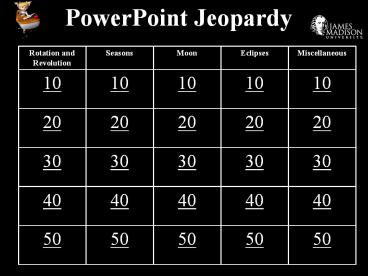PowerPoint Jeopardy - PowerPoint PPT Presentation
1 / 26
Title:
PowerPoint Jeopardy
Description:
PowerPoint Jeopardy Miscellaneous Eclipses Moon Seasons Rotation and Revolution 10 10 10 10 10 20 20 20 20 20 30 30 30 30 30 40 40 40 40 40 50 50 50 50 50 _____ is ... – PowerPoint PPT presentation
Number of Views:93
Avg rating:3.0/5.0
Title: PowerPoint Jeopardy
1
PowerPoint Jeopardy
Rotation and Revolution Seasons Moon Eclipses Miscellaneous
10 10 10 10 10
20 20 20 20 20
30 30 30 30 30
40 40 40 40 40
50 50 50 50 50
2
__________ is the spinning of Earth on its axis.
3
_________ is the movement of one object around
another.
4
Earths rotation takes about _________________.
5
One complete revolution of Earth takes __________.
6
Day and night are caused by Earths
_______________.
7
The beginning of spring in the Northern
Hemisphere is marked by the _________ ________.
8
- Earth has seasons because
- Earth rotates on its axis
- the distance between Earth
- and the sun changes
- Earths axis is tilted as it
- Moves around the sun
- d. The temperature of the sun changes
9
- When the north end of Earths axis
- is tilted toward the sun, North America
- will experience
- More indirect rays and shorter days
- More indirect rays and longer days
- More direct rays and longer days
- More direct rays and shorter days
10
An equinox occurs when ____________________. A
solstice occurs when ____________________.
11
In the Southern Hemisphere, the summer Solstice
occurs when the sun is directly overhead at
_____________. (number)
12
- Because the moon rotates once for
- each revolution around Earth,
- You see some phases more than others
- a different side of the moon faces
- Earth each day
- c. you never see the far side of the moon
- d. the far side of the moon is visible
- only during the full moon phase
13
- The phase of the moon you see depends on
- Where you are on Earths surface
- How much of the sunlit side of the
- moon faces Earth
- How much of the moons surface
- is lit by the sun
- d. Whether or not an eclipse is occurring
14
From the new moon phase to full moon phase, you
see a (n) increasing decreasing the same
amount of light.
List the phases of the moon in order, starting
with the new moon phase.
15
- The amount of the lighted side of the moon
- you can see is the same between which phases?
- new moon and full moon
- new moon and first quarter
- first quarter and third quarter
- full moon and third quarter
16
The moon can be seen from Earth
because _____________________.
17
- For a solar eclipse to occur,
- The sun must be directly between
- Earth and the moon.
- b. Earth must be directly between
- the sun and the moon
- The moon must be directly behind Earth
- The moon must be directly between
- Earth and the sun.
18
During what phase can a lunar eclipse occur?
19
The darkest part of the moons shadow is called
the ____________.
20
During a partial solar eclipse, part of the sun
is visible in the ____________, the lightest part
of the moons shadow.
21
Explain how a lunar eclipse differs from a solar
eclipse.
22
The force of ________ by the moon pulls on the
water of Earth.
23
During a full moon or a new moon, the high tides
will be _____ and the low tides will be _____.
24
Neap tides occur at which 2 phases of the moon?
25
If high tide occurs at 600 am, at what
approximate time will the next high tide occur.
26
Everything (rotates/revolves) in a
(circular/elliptical) path.































